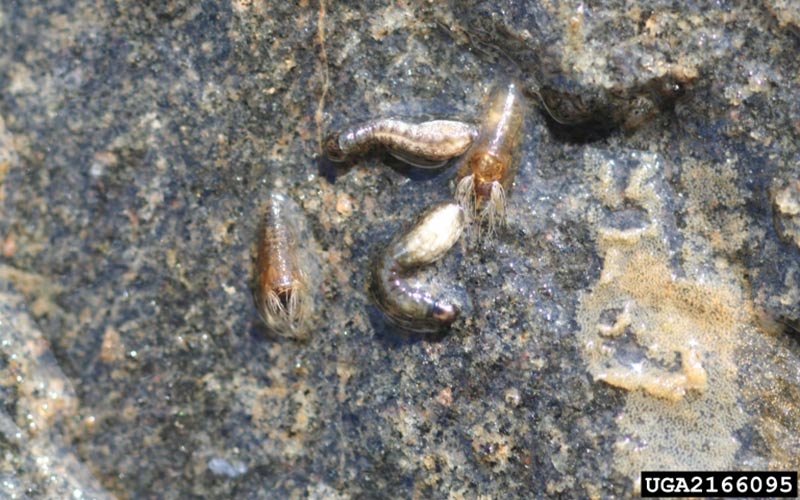How to Kill and Control Black Flies in Your Yard
Once you experience a black fly invasion, you have a new perspective on flying pests. These black flies aren't dark house flies — they're biting insects that create painful wounds that itch for weeks. Black fly problems have escalated in the Midwest and other parts of the country over the last several years. By understanding these pests, you can get rid of black flies and protect your family against their bites.

Female black flies lay hundreds of eggs that hatch into developing larvae underwater.
Identifying Black Flies
Depending on where you live, you may know black flies by many names, including buffalo gnats, turkey gnats, no-see-ums, sand flies and punkies. Several species of tiny, dark flies fall under these banners. Black flies can grow up to 1/3 inch in length, but some types are a fraction of that size. Despite their differences, black flies share a unique profile: They have a shiny, buffalo-like hump right behind their heads.
Black fly larvae develop in water, much like mosquito larvae do. But while mosquitoes prefer stagnant water, black flies prefer clean, slow-moving streams. To a black fly, the moving water in your favorite garden water feature works just fine for laying eggs.

Black flies have a visible hump right behind their heads.
Whitney Cranshaw, Colorado State University, Bugwood.org (CC BY 3.0 US)
Understanding the Black Fly Life Cycle
Depending on the weather, adult black flies appear in mid-spring. They emerge from water, where eggs and larvae overwintered. Adult black flies can live from two weeks to nearly three months.1 The adults mate near the water where their larvae developed, but female black flies need a blood meal to lay their eggs. Similar to female mosquitoes, black fly females seek out animals — including birds, pets and humans — to get the blood they need.
After feeding, females lay up to 800 eggs each in unpolluted, moving water.1 Eggs are laid on the water or just below the water's surface on aquatic plants and rocks. After hatching, larvae attach themselves to rocks or vegetation in the stream. Depending on the species and water temperature, black fly larvae can take from 10 days to several weeks to mature, pupate and become adults. When heavy rainfall keeps streams moving, several generations can occur per year.

Black fly larvae transform into flying, biting pests.
Photo credit: Whitney Cranshaw, Colorado State University, Bugwood.org (CC BY 3.0 US)
Protecting Against Black Flies
Not all black fly species bite humans, but those that don't are nuisances just the same. They buzz around eyes, dive up noses and fly into ears — often converging in cloud-like swarms. When black flies bite, they slice into skin and inject toxins that encourage blood flow and trigger allergic reactions in some. The swollen bites itch and hurt for days or even weeks. In severe black fly infestations, birds and animals may die from blood loss.
Effective control combines residual insecticides with treatments that clear outdoor areas so that you can enjoy your home:
Amdro Quick Kill Insect Killer for Lawn & Landscape Ready To Spray and Amdro Quick Kill Insect Killer for Lawn & Landscape Concentrate kill black flies by contact. Then they keep protecting against new black flies for up to three months. Treat lawns, trees, shrubs and flower gardens to reach adult black flies in their hiding places. Both these products also kill and control biting mosquitoes and aggressive yellow jackets, too.
By learning to recognize black flies and their biting habits, you can take action to protect your family and property against black fly invasions and painful bites. With Amdro brand, you can get kill and control black flies, put an end to pest disruptions and enjoy your yard with family and friends.
Always read product labels thoroughly and follow instructions.
Sources:
1. J.F. Butler, "Black Flies," University of Florida Entomology and Nematology.




